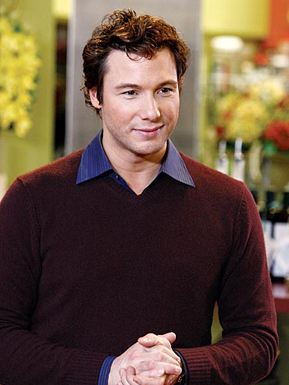Top Chefs: Rocco DiSpirito
Up, down, and around, but the meatballs remain

What are the essential elements of a great chef? As this week’s snapshots of five great chefs illustrate, the answers run from soup to nuts, or when it comes to fields of study, from education to graphic arts. The common ingredient: Boston University, which has been cooking up culinary talent for decades, sometimes in unexpected corners. The culinary arts program, started with help from America’s first top chef, Julia Child (Hon.’76), has delivered many successes, and the School of Hospitality Administration has prepared many more for rewarding careers in the big leagues of the restaurant business.
How does it work? Every day this week, one of BU’s best-known chefs tells us about getting from here to there.
As Rocco DiSpirito tells it, he started cooking when he was an 11-year-old kid in Queens, mainly because his mother refused to give him any spending money. His first job, at Sal’s Pizzeria, made him an expert at opening tomato cans, grating cheese, and filling sodas — at $30 a week.
“I knew immediately I loved the restaurant world,” says DiSpirito (SHA’90). “Every job I had after that was in the restaurant business.”
At age 16, DiSpirito enrolled in the Culinary Institute of America, then went on to study in Paris and cook at top New York hotels. In 1988, with 10 years of cooking under his belt, he decided that a more formal education would serve him well in the increasingly competitive restaurant business. The School of Hospitality Administration offered him an accelerated two-year program, and he took it.
DiSpirito emerged as a presence in the foodie universe in 1997, when he opened Union Pacific in Gramercy, and New York Times food critic Ruth Reichl gave the restaurant three stars. It also won praise from Gourmet, Food & Wine, and People, which in 2002 dubbed DiSpirito the Sexiest Chef Alive. DiSpirito was known for his fearless “focus on flavor,” evident in dishes like scallops and sea urchin with essence of tomato and mustard oil, halibut braised in goose fat with ginger, and mango and papaya carpaccio with pineapple sherbet and candied cilantro.
In 2003, he went from foodie darling to household name when cameras captured the opening of his namesake New York City eatery for the reality series The Restaurant. The show aired for two seasons, documenting kitchen dramas, romances, and tantrums, and the chef-star rose to national fame. Then he fell. In 2004, the series fizzled and DiSpirito’s two restaurants closed. Critics accused him of selling out his considerable talent for the glamour of TV stardom.
These days, DiSpirito is settled between the two: writing cookbooks and appearing regularly on The Biggest Loser, Top Chef, Rachael Ray, and his own cooking program on A&E, Rocco Gets Real. He was even a contestant on Dancing with the Stars, which the Ironman triathlete says was one of the most physically demanding things he’s ever done.
DiSpirito says he has no plans to return to the restaurant world. He is writing his sixth cookbook, doing charity work at food banks, and serving his mama’s meatballs to friends at home in Manhattan. His current mission, he says, is preaching the “gospel of the reformed gourmet,” which encourages cooks to be more concerned with having fun than with having a high-end dining experience. DiSpirito says it’s OK if home cooks cheat a little and pull together a quick meal. The real goal should be getting everyone around the dinner table.
“No one wants to eat alone,” DiSpirito says. “It’s our last daily ritual.”
Rocco DiSpirito’s Mama’s Meat Balls
1/3 cup chicken stock
1/4 yellow onion
1 clove garlic
1/4 cup fresh Italian flat-leaf parsley, chopped fine
1/2 pound ground beef
1/2 pound ground pork
1/2 pound ground veal
1/3 cup plain bread crumbs
2 eggs
1/4 cup Parmigiano-Reggiano, grated
1 teaspoon red pepper flakes
1 teaspoon salt
3-6 cups of Mama’s Marinara or your favorite marinara sauce
1/4 cup extra-virgin olive oil
Place the chicken stock, onion, garlic, and parsley in a blender or food processor and puree.
In a large bowl, combine the pureed stock mix, meat, bread crumbs, eggs, Parmigiano-Reggiano, red pepper flakes, parsley, and salt. Combine with both hands until mixture is uniform. Do not overmix.
Put a little olive oil on your hands and form mixture into balls a little larger than golf balls. They should be about 1/4 cup each, though if you prefer bigger or smaller, it will affect only the browning time.
Pour about a half-inch of extra-virgin olive oil into a straight-sided, 10-inch-wide sauté pan and heat over medium-high flame. Add the meatballs to the pan (working in batches if necessary) and brown meatballs, turning once. This will take about 10-15 minutes.
While the meatballs are browning, heat the marinara sauce in a stockpot over medium heat. Lift the meatballs out of the sauté pan with a slotted spoon and put them in the marinara sauce. Stir gently. Simmer for one hour.
Serve with a little extra Parmigiano-Reggiano sprinkled on top. Serve alone or over spaghetti (in which case, you will need 6 cups of marinara).
This article originally appeared in the summer 2009 Bostonia.
Comments & Discussion
Boston University moderates comments to facilitate an informed, substantive, civil conversation. Abusive, profane, self-promotional, misleading, incoherent or off-topic comments will be rejected. Moderators are staffed during regular business hours (EST) and can only accept comments written in English. Statistics or facts must include a citation or a link to the citation.